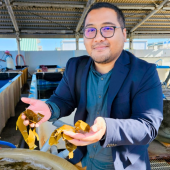

Importance of exploring wild populations of Eucheumatoids for sustainable seaweed industry in Indonesia
Eka Sunarwidhi Prasedya, Ph.D., Associate Professor, University of Mataram, Indonesia
Presentation:
Indonesia currently holds the top position as the leading global producer of carrageenan, which is derived from seaweeds belonging to the Eucheumatoid group. The seaweed group primarily comprises the two generas Kappaphycus and Eucheuma. Nevertheless, the escalating impacts of climate change, such as rising sea levels, higher sea temperatures, and susceptibility to diseases like ice-ice, are leading to a gradual decrease in the Eucheumatoid productivity of carrageenan seaweed producing nations, including Indonesia. Therefore, it is necessary to investigate novel wild strains that possess resilience and adaptability to the existing climate conditions. Our team extensively sampled wild (non-cultivated) Eucheumatoids in two highly diverse regions in Indonesia: West Nusa Tenggara and East Nusa Tenggara. The identification of seaweed genetics was conducted using two molecular mitochondrial markers, the cytochrome subunit 2 and 3 spacer (cox2-3s) and cytochrome subunit 1 (cox1). The present outcome exclusively emphasizes the novel haplotype Kappaphycus sp. We analyzed the growth and biochemical performance of the novel strain.

